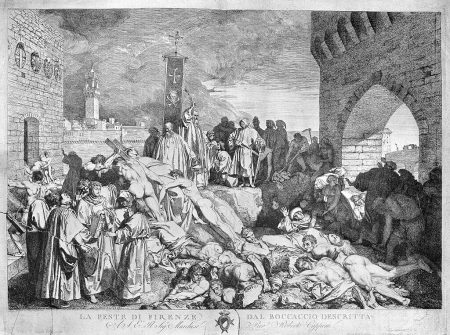
Plague in Florence 1348 from Boccaccio's Wellcome, By
https://wellcomeimages.org/ - CC By 4.0
For most of my life I’ve been a fan of end-of-the-world movies, but now that the end times are surely upon us, the genre feels particularly apropos. Not that I especially want to watch them right now — these days, I’m preferring old musicals with cheery melodies and lots of tap dancing. But I’m glad I did watch the end of the world flicks when they came out. They’ve given me good preparation for global disasters of all kinds including asteroids, Planet X, aliens, nuclear wars, fascist pod people, smart computers, zombie epidemics, and generic apocalypses from A to Z.
Admittedly, coronavirus would probably make a pretty static end-of-the-world movie given that most of the participants are just locking themselves in their homes trying not to catch coronavirus. Nevertheless, if someone wanted to make a disaster film out of it, they could.
They would make much of hand-washing. There would be long shots of hand sanitizer and ominous music whenever someone failed to wash their hands properly. Frenzied scenes in hospitals as beleaguered medics struggle to save the afflicted. Dramatic scenes in grocery stores or on the highway as the kids try to get away, only to be stopped by cops, except, oh no, the cops have — coronavirus! Ok, it’s not quite as exciting as zombies but you’ve got to work with what you’ve got.
There are other required scenes. In any good disaster epic, everything seems normal when the film begins, but you know from the buzz of televisions in the back of otherwise ordinary scenes that something big is about to happen. With coronavirus, we had a week or so of that, starting in early March, when the news about Covid-19 made some people uneasy enough to buy beans, rice, and extra toilet paper.
There’s the classic moment where it’s obvious the disaster is going to happen and everyone panics. With coronavirus, that started around March 11 when the big grocery stores were bought out of everything every day through Sunday. Nothing like empty shelves to evoke the end of the world.
After the initial panic, there’s another big moment where our heroes have time to realize that everything is different now and there’s no going back. In most films, this is a sad and reflective moment as they realize just how fucked they are. We got a taste of that in the days that followed the big shopping spree. In the course of just a few days, everything closed. Schools, churches, libraries, zoos, museums, theatres, bars, restaurants, some retail, all the colleges, government offices, you name it. One week into America’s bout with coronavirus, and already, everything is different.
Many disaster epics have at least one skeptic, and coronavirus has millions. Given the massive mobilization of response, that number may be dwindling as it becomes increasingly hard even for hardcore skeptics to maintain that coronavirus is no big deal or a hoax to make Trump look bad. The enormity of the shut down in Coronavirus: The Movie is ominously convincing. No one shuts down the whole world for no reason.
Today, in the real world, we’re all in voluntary isolation. In a disaster epic, voluntary isolation would be martial law. No one in or out. No one past the checkpoint! This is already the case in China, Italy, and France where lockdown is not optional and you need a permission slip to go to the store. Closer to home, lockdown is already happening in San Francisco and there are rumors that it could be coming to New York City too, although the Governor says no. This lends a new dramatic wrinkle to the plot.
How does it end? Well, typically after the hunkering down phase, there’s a big climactic scene where the heroic lead has to fight the villain, in this case coronavirus, and it almost gets him but through courage, pluck, and perhaps a touch of the supernatural, our hero emerges victorious! Or, a supporting actor gets the virus and the heroic lead has to save them. Either way, you know a vaccine will be involved.
Once that’s out of the way and everyone is saved, we can do the final action scene as the sun rises on a changed world. Probably you’d want a few bodies around for effect and it would be eerily quiet. Then, as the sun rises higher, people in the suburban subdivision where we would inevitably find ourselves stumble out of their homes, some for the first time in months, all looking up, blinking, shell-shocked, into a pale blue sky.
Oh wait –last scene, three months later. Everything seems normal again, but this being a disaster film, the camera has to tease us one last time. A bottle of hand sanitizer is perched on a park bench, a man sleeping beside it. The wind blows back a lock of his hair but otherwise he is still. The camera holds the shot — Is he sleeping, you wonder?
Fade to black.
Photo credit: By https://wellcomeimages.org/indexplus/obf_images/e2/78/a40362372a6f19abb7497801c848.jpg Gallery: https://wellcomeimages.org/indexplus/image/L0004057.html Wellcome Collection gallery (2018-04-05): https://wellcomecollection.org/works/awnp6vyq CC-BY-4.0, CC BY 4.0, https://commons.wikimedia.org/w/index.php?curid=35866769




